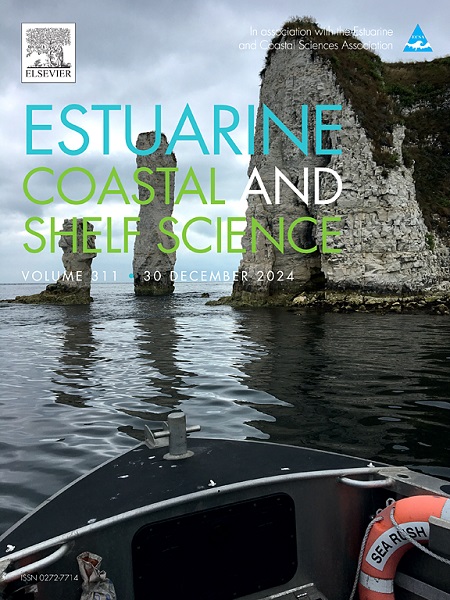Impacts of land use change on mangrove blue carbon services: A future perspective in northeastern Brazil
IF 2.6
3区 地球科学
Q1 MARINE & FRESHWATER BIOLOGY
引用次数: 0
Abstract
Mangroves are important Blue Carbon (BC) ecosystems, providing worldwide climate regulation and other ecosystem services. However, the demand for several economic activities has led to land use changes, which can impact mangrove BC services. This paper aims to analyze the effects of land cover conversion scenarios on mangrove dynamics and BC services delivery along the western South Atlantic coast over 27 years (2023–2050). We developed future scenarios of mangrove conversions by applying the InVEST Scenario Generator tool and using historical conversion rates from analyzing remote sensing hybrid images. Maps of future mangrove species distribution were subsequently used to estimate carbon stocks and emissions, total Net Carbon Sequestration (NCS), and Net Present Value (NPV) by using the InVEST BC model. Based on our results, forest area could decrease by about 7.1% and total carbon stored by 7% by 2050, mainly driven by the expansion of shrimp farms. The total NCS could reach an average value of about 20.1 tCO2e × ha−1 × yr−1, and the average NPV could get at ≈ US$8000 × ha−1 × yr−1. By 2050, the lowest values of carbon stocks (321 tCO2e × ha−1) and highest values of carbon emissions (>600 tCO2e × ha−1), as well as economic losses (>US$200 thousand × ha−1), seem to be concentrated along the mangrove edges, which suffer more from high-impact human activities such as salt extraction and shrimp farming. Results highlight the dynamics of Brazilian mangroves BC services and the need for protective measures and restrictions against the advance of high-impact land uses over these ecosystems.
土地利用变化对巴西东北部红树林蓝碳服务的影响:未来展望
红树林是重要的蓝碳(BC)生态系统,提供全球气候调节和其他生态系统服务。然而,一些经济活动的需求导致了土地利用的变化,这可能会影响红树林的BC服务。本文旨在分析27年来(2023-2050年)南大西洋西部沿岸土地覆盖转换情景对红树林动态和BC服务提供的影响。我们通过应用InVEST Scenario Generator工具并利用分析遥感混合图像的历史转化率,开发了红树林转换的未来场景。随后,利用InVEST BC模型,利用未来红树林物种分布图来估算碳储量和排放量、总净碳固存(NCS)和净现值(NPV)。根据我们的研究结果,到2050年,森林面积将减少约7.1%,总碳储量将减少7%,这主要是由于对虾养殖场的扩张。总NCS可达到平均约20.1 tCO2e × ha - 1 × yr - 1,平均NPV可达约8000美元× ha - 1 × yr - 1。到2050年,碳储量的最低值(321 tCO2e × ha - 1)和碳排放量的最低值(600 tCO2e × ha - 1)以及经济损失(20万美元× ha - 1)似乎集中在红树林边缘,这些地区受到高影响的人类活动(如采盐和养虾)的影响更大。结果强调了巴西红树林BC服务的动态,以及需要采取保护措施和限制措施,以防止对这些生态系统产生高影响的土地利用的推进。
本文章由计算机程序翻译,如有差异,请以英文原文为准。
求助全文
约1分钟内获得全文
求助全文
来源期刊
CiteScore
5.60
自引率
7.10%
发文量
374
审稿时长
9 months
期刊介绍:
Estuarine, Coastal and Shelf Science is an international multidisciplinary journal devoted to the analysis of saline water phenomena ranging from the outer edge of the continental shelf to the upper limits of the tidal zone. The journal provides a unique forum, unifying the multidisciplinary approaches to the study of the oceanography of estuaries, coastal zones, and continental shelf seas. It features original research papers, review papers and short communications treating such disciplines as zoology, botany, geology, sedimentology, physical oceanography.

 求助内容:
求助内容: 应助结果提醒方式:
应助结果提醒方式:


